AI and Big Data: A Perfect Match for Modern Businesses

Information is priceless. With enough information and knowledge on how to properly use it, a business can rise over its competitors, a scientific organization can make incredible discoveries, and complex, multivariable planning becomes but a routine process.
This is the primary reason why big data is such a big deal today (pun intended). Talking about big data, we’ve already mentioned it in the context of its business impacts and the problems that arise when annotating big data sets. However, the scope of this topic is much larger. In this article, we’d like to cover the pros and cons of big data, how big data is used with AI, why it’s essential for modern machine learning, and what prospects lie ahead of big data.
What’s Big Data?
It is a well-known fact that around 90% of all information existing today was generated in the last few years. With the development of technologies such as AI, this trend promises to keep up at the same speed with all the data we get from traditional sources like documents and reports, sensor data from IoT devices, social media, transaction data, etc.
Big data is the perfect tool for sophisticated AI analytics. It comes from the variety of data sources generated on a daily basis by individuals and enterprises. Big data can be used for decision-making in processes to boost the productivity previously reached by traditional methods. Click to TweetThe big data can be characterized by the 3 “V”s:
- Volume: big data exists in much larger quantities than ever before
- Velocity: big data requires to be processed in a timely manner
- Variety: big data comes in many forms (structured and unstructured) and formats (from text to images to audio to video)
We’ve just used a lot of fancy words to make the concept of big data sound important and complicated. Let’s use a simple example to explain the phenomenon.
To Put It Simply: A Nifty Use Case of Big Data in AI
Imagine that you run an online store that sells clothes. Your goal is to attract more customers and build a loyal customer base by increasing retention. Can AI help you with that? Absolutely! Designing an artificial intelligence algorithm that will see and store the preferences of your website’s visitors will help you offer them what they want. If your AI algorithm is smart enough, the consumers will see what they want to buy.
So how do you make your artificial intelligence algorithm smart enough? There’s a lot of factors that impact the decision-making process of any of your visitors: the need, the price, the style, to outline the tip of the iceberg. What about the things they bought before? How long do they spend on each page, considering different options? Their personal style? The accessories that go along with certain clothing items? The answer to any of these questions can make the sale and help you keep your customer.
Keep in mind not every customer profile will have answers to each of these questions. In order to build a customer profile that covers so many details and could potentially sell, you need a lot of data. Moreover, you need this data to make sense, i.e. for it to be readable by your machine learning algorithm.
Pros and Cons of Big Data
While big data is the perfect source for AI analytics, it comes with its own features and limitations. In order to better understand the efficient application of big data, it’s important to know its pros and cons first.
Advantages of Big Data
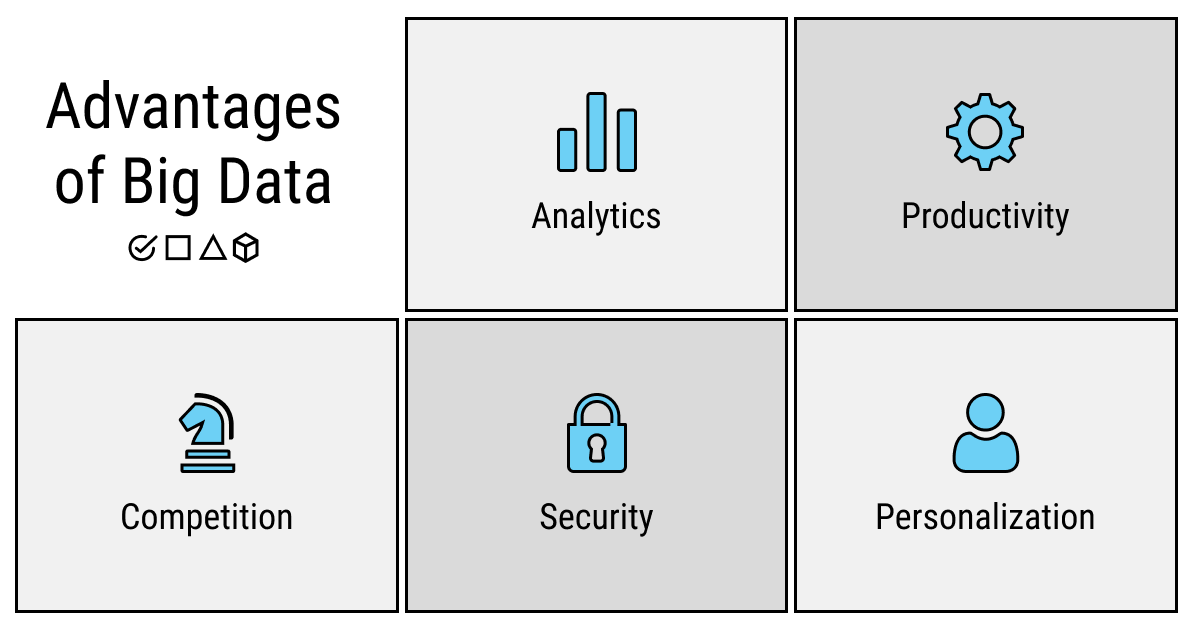
- Sophisticated analytics. This is the primary reason that businesses and organizations decide to use big data in AI. With its massive volumes, business data analytics allows finding patterns on a much larger scale, as well as look for better strategies and solutions that are far more nuanced and fit for specific situations.
- Competitive advantages. With better analytics comes a competitive advantage. It’s easy to replicate a single big change but nearly impossible to trace the variety of minute tweaks that make modern businesses succeed.
- Enhanced productivity. As big data helps you find outdated or obsolete operations processes, it brings along automation and helps you improve performance. This in its turn leads to the reduction of operational costs.
- Personalization. One thing that can help you reduce customer churn is improving customer experiences, and what best way for it than personalization? With AI and big data at hand, you are able to analyze and find patterns in customer behaviors to offer additional value for the consumers and build a stronger, more loyal customer base.
- Security against fraud and errors. AI predictions allow not only to make propitious decisions but also detect fraudulent activity and potential mistakes. Early detection of errors and fraud benefits the business’s reputation and improves customer experiences.
Problems and Flaws of Big Data
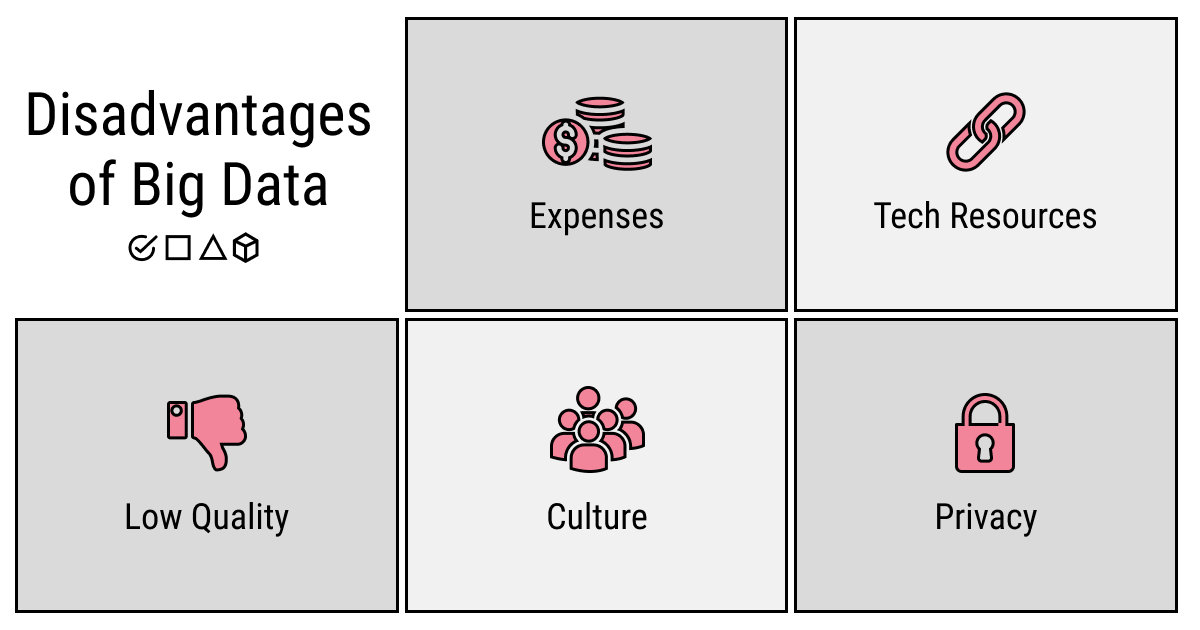
- High expenses to collect, manage, and store big data. Big data is expensive, both in terms of collecting and managing it. You’ll require enough storage space to keep it, too. If you don’t have sufficient capacity to keep big data and refresh it regularly, you’ll end up wasting your efforts, time, and precious resources.
- The increasing level of irrelevant and low-quality data. With big data comes a big percent of bad data. This is just pure maths: if the volume of the data you collect grows, you’ll have to deal with the growing number of poor quality data to process and refine.
- Business culture reimagining. If you decide to build your business on big data, your business culture will require a makeover. Big data will bring efficiency, security, and better decision-making, which will affect every aspect of your organization. Whatever industry you’re in, big data analytics is bound to make an impact.
- Data privacy issues. From data leakage to sensitive information collection for artificial intelligence algorithms, big data is prone to the problem of breaking privacy laws. This is especially true for industries with highly sensitive data like finance or health care.
- Computational and human resources cost. While we already mentioned that big data is expensive, this is another spectrum of the same problem. In order for big data to serve you well in your AI project, you’ll require the technical expertise and resources that not every organization can afford.
AI vs Big Data: How Do They Work Together?
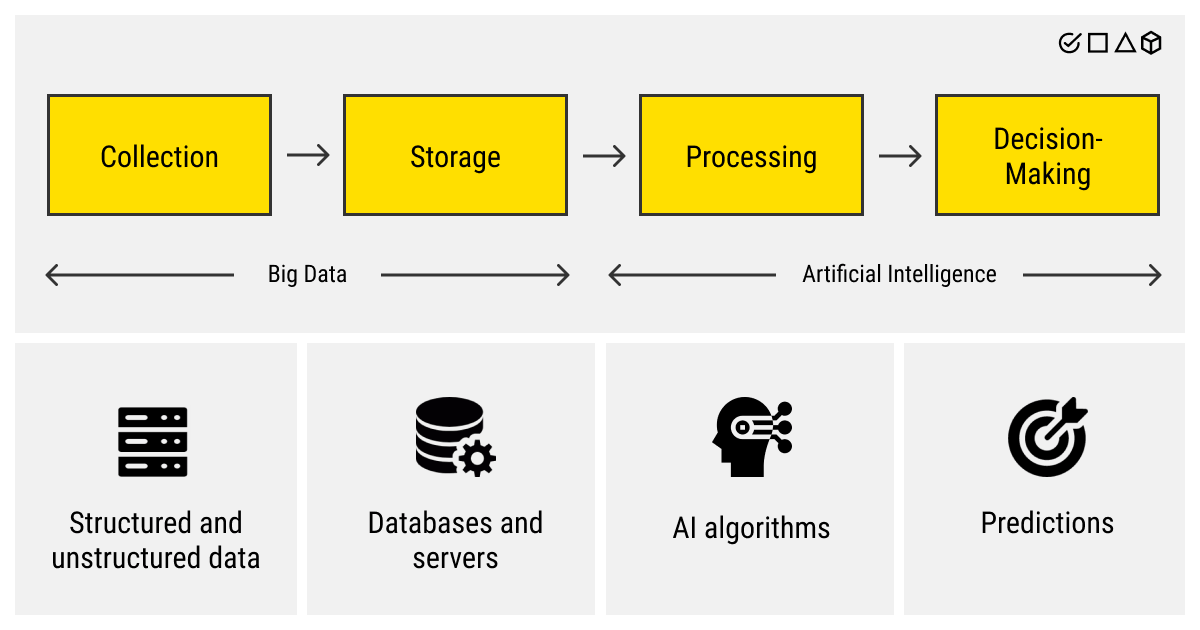
Now that we have not just data but big data on our hands, the focus shifts from the question “Where do we get the data?” to “How to use it efficiently?”. Overall, only about 20% of the data is used by a business today. The rest of the data at the organization’s disposal is left untouched due to a variety of issues, starting from its hard-to-manage volumes to unstructured or heterogeneous nature to the lack of data quality and relevance.
But AI can come to the rescue. Artificial intelligence can help with managing big data. Predictive AI essentially is about finding patterns in scenarios and data sets that are too voluminous or laborious for the human mind to handle. It’s one of the primary tasks for the algorithms and, naturally, it should be used to help with the management of big data.
On the other hand, your AI algorithm will only get as good as your data. The more high-quality data you feed into it, the better it will become pattern recognition, prediction-making, and doing its job altogether. So, as you can see, artificial intelligence and big data have a co-dependent relationship where they work best together.
Why Does AI Need Big Data: AI Data Analytics
Undoubtedly, big data is an essential part of any modern AI project. And it seems pretty obvious why: train your algorithm on a bit of data, and it gets smart enough to make predictions it was designed for. Give it more data, and it will get smarter and make better predictions.
But here’s an interesting question for you: how much data do you actually need? And an even more interesting one: can big data be too big?
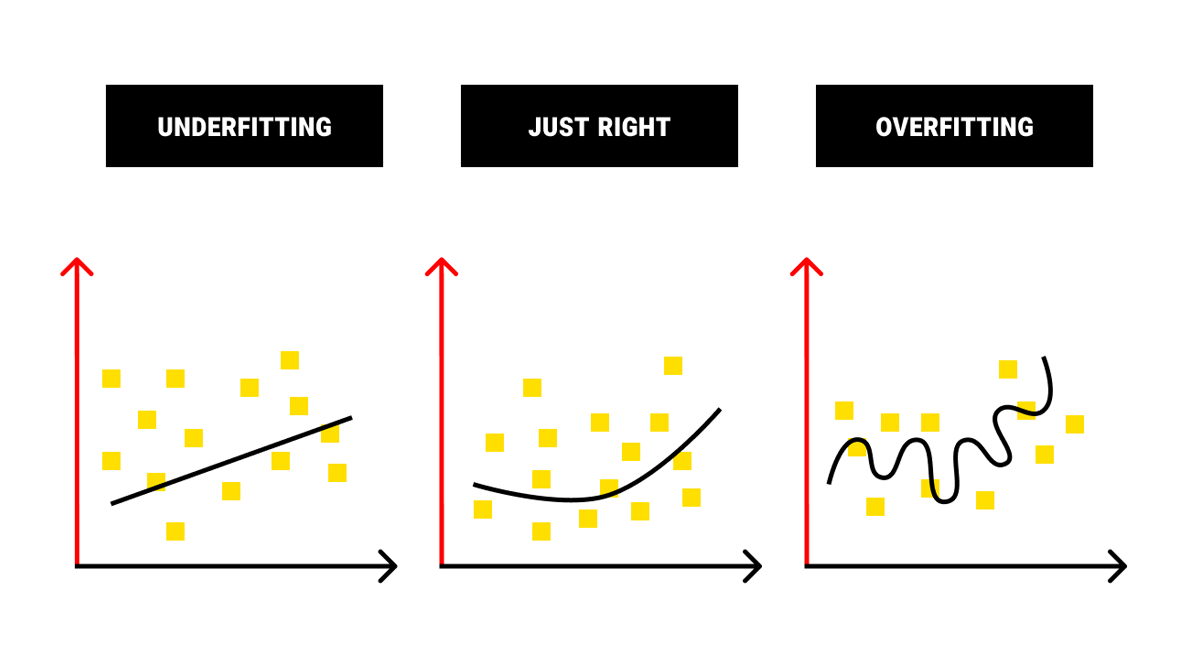
The answer to both of these questions lies in the concept of underfitting and overfitting. We’ve discussed these phenomena when talking about the stages of an AI project. In a nutshell, more data usually leads to a better-trained model. If you don’t provide enough data, you risk underfitting, which means the predictions of your artificial intelligence algorithm won’t be accurate enough. Seems about right, doesn’t it?
On the other hand, using too much data can lead to the contrary phenomenon known as overfitting. It results in the model giving predictions that are too accurate. The problem with this scenario is that a lot of AI data analytics is based on generalization and extrapolation. Combined with the fact that it’s nearly impossible to take into account every factor that influences your real-life target area, overfitting only gives accurate predictions in specific cases. The AI algorithm won’t be able to successfully predict on a bigger scale and for the scenarios with little known initial data.
Yet, there is no formula to calculate how much big data you need to train your artificial intelligence algorithm. Generally, an experienced data scientist or engineer will have an approximate idea about the volume of data you’ll need. For more specifics, practice makes perfect. Don’t forget to make backups when training your model, and don’t be afraid to try for the best result.
Why Does Big Data Need Artificial Intelligence: AI Data Analysis
So, artificial intelligence needs big data to train and get smarter, duh. Now let’s look at the problem from a different perspective.
To train your AI model, you need not just any data but high-quality, relevant, clean, and well-annotated data. However, if you remember, we’ve mentioned that the more data you collect, the higher the chance it is of poor quality. It doesn’t mean the data is unusable but it requires processing to be fit for training AI algorithms.
AI can help with structuring, processing, and managing big data. In certain cases, it can also help with annotating the data (such as for semi-supervised learning models). In the realities of a modern business environment, around 80% of the time for any AI project is spent on data processing tasks.
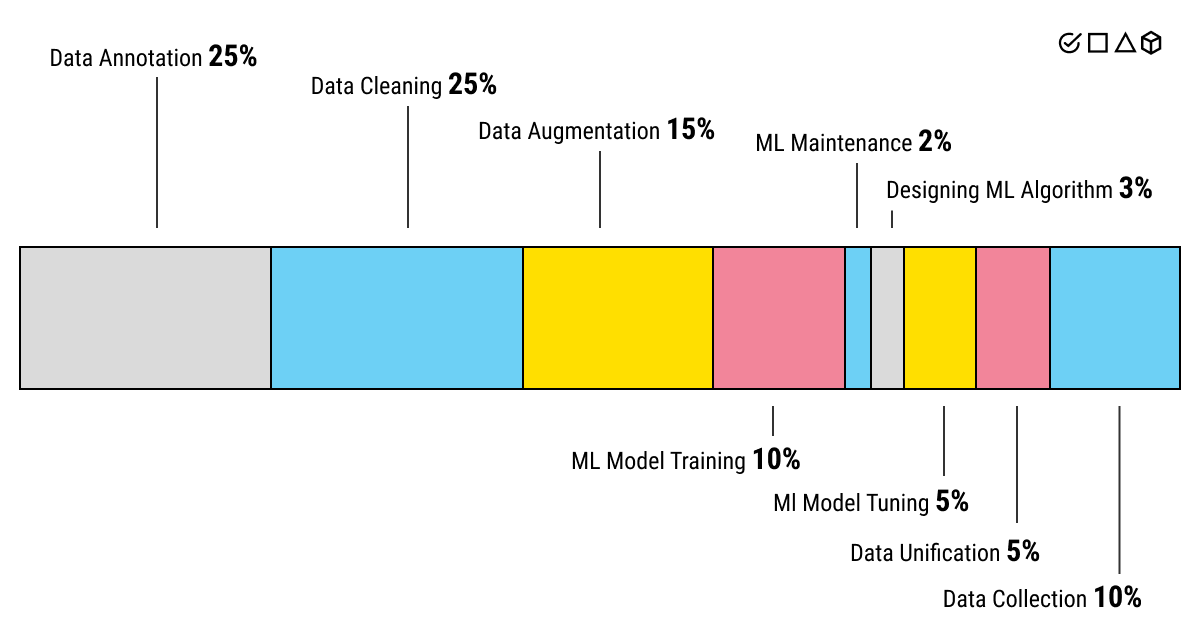
There’s a lot that needs to be done with the data before it’s ready to be used to train an AI model. After collecting, you need to clean the data (e.g., remove all duplicates and fill in the missing data pieces) and unify it (by formatting, converting, and scaling). You need to label it with as few errors as possible to ensure the high quality of the future AI training of your algorithm. There’s also the issue of data privacy: depending on how sensitive the data is, you might need to anonymize and randomize your data set.
As you can imagine, a business rarely has the time or resources to spend on tasks that do not create direct value (like designing or deploying an ML model does). AI can help with some of these tasks by introducing new methods to analyze the data. With the help of ML algorithms, data analysis becomes much less labor-intensive. Artificial intelligence can also facilitate the storage and sharing of big data. By spending some time creating AI algorithms to deal with the tedious and time-consuming data-related tasks, you can potentially save a lot of effort and resources for your team in the future.
The Future of Big Data in AI: Where Do We Go from Here
In the modern world, AI and big data already go hand in hand, and the current trend won’t likely change in the near future. On the contrary, it looks like this union of technology and data will bring new bright perspectives to the proverbial table.
Let’s take a look at a few predictions we’re curious to see coming true:
- While people will still matter a lot, the stellar combo of big data and artificial intelligence will help us build the work and business models that require less supervision from human professionals. Instead, people will be able to concentrate on the tasks that add more value, the tasks that necessitate creativity and strategic planning.
- Even more personalization is on the way! With the amount of data growing every day and the ability of AI to help with its processing and labeling, it is only natural that soon algorithms will be able to predict with astounding accuracy what each individual consumer actually wants.
- More big data means alternative ways of storing and managing data sets. Cloud computing will be the technology of choice for many businesses in the near future due to its speed, holding capacity, and accessibility.
- The future of AI and big data will not come without its challenges. The ethical perspective is already named by certain stakeholders as the area of significant problems. Specifically, the Internet of Behavior (the ability of big data and AI to shape the patterns of social behaviors) is named as the major risk in the coming years.
- Data privacy and security have already been established as areas of great concern both for the public and the governments. It is likely that the industry standards and governing principles will continue to get more complex and nuanced following the growing number of precedents.
All in all, there’s a lot of interesting things to come, both lucrative and otherwise. We at Label Your Data are looking forward to seeing how the situation develops.
Written by
Karyna is the CEO of Label Your Data, a company specializing in data labeling solutions for machine learning projects. With a strong background in machine learning, she frequently collaborates with editors to share her expertise through articles, whitepapers, and presentations.

